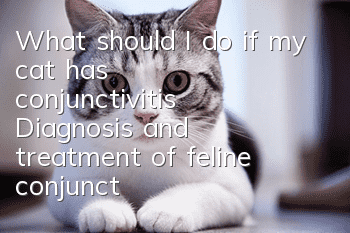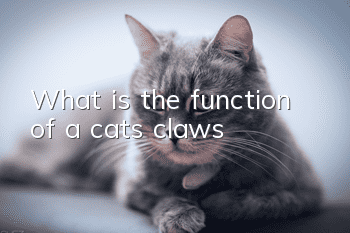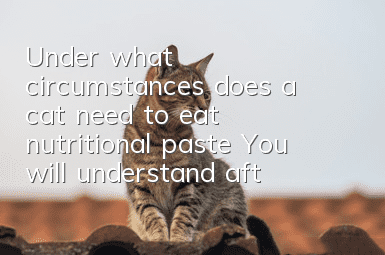What should I do if my cat has conjunctivitis? (Diagnosis and treatment of feline conjunctivitis)

A cat's conjunctiva is a layer of epithelial cells, mucus-secreting cells that cover the eyeball and line the eyelids. The conjunctiva is invisible in healthy cats. Feline conjunctivitis is a common eye disease, which is inflammation of the conjunctiva.
Types and symptoms of cat conjunctivitis:
1. Acute conjunctivitis
Symptoms: The sick cat’s eyes are photophobic, tearful, red and swollen eyelids, conjunctival congestion, and a large amount of sticky secretions.
2. Chronic conjunctivitis (acute conjunctivitis that lasts for more than a week will turn into chronic conjunctivitis)
Symptoms: The conjunctiva is protruding, hypertrophic and red, with a small amount of secretion.
3. Purulent conjunctivitis
Symptoms: The conjunctiva is obviously congested and edematous, the eyes have a large amount of purulent secretions, and the upper and lower eyelids are often stuck together.
Causes of cat conjunctivitis:
The causes of conjunctivitis are divided into two categories: infectious and non-infectious according to their different properties.
Infectious causes: Infectious causes are bacterial or viral infections, which often irritate the conjunctiva and make it susceptible to secondary bacterial infection. Common bacteria and viruses that cause conjunctivitis include:
-
Feline Herpes Virus
-
Chlamydia
-
Mycoplasma
-
Feline infectious rhinotracheitis virus (FVR)
-
Feline calicivirus
-
Streptococcus
-
Staphylococci
Non-infectious causes:
-
Accidental injury to the conjunctiva caused by foreign matter entering the eyelids, such as sand or dust
-
Conjunctival inflammation caused by external injuries to the eyes, such as scratches from fights between cats, accidental bumps, etc.
-
Cat eye eyelashes are inverted, and long-term friction in the eyes can cause inflammation.
-
Blocked tear ducts
Diagnosis of conjunctivitis in cats
Usually knottedThe diagnosis of inflammation is mainly based on daily observation. Once non-infectious causes such as foreign bodies in the eye or eye injuries are ruled out, it can be tentatively determined to be caused by infectious causes.
Usually most cases of feline conjunctivitis are caused by an infectious virus. Generally, if family conditions are limited, affected cats can be sent to the hospital for more advanced diagnosis such as bacterial culture, cytology examination, and DNA testing. Diagnosis can generally be made based on medical history and clinical symptoms. Most affected cats are between 5 and 12 weeks old. Herpes virus infection is very common for young cats, especially when they are affected by adverse conditions such as malnutrition and poor living environment.
Treatment of conjunctivitis in cats:
The treatment of feline conjunctivitis should first remove the predisposing factors as soon as possible and focus on treating the primary disease. Treatment method for non-infectious causes: 3% boric acid water or 0.1% Rivanol solution can be used to clean the affected eye. During the eyewash process, carefully check whether there are any foreign objects behind the conjunctival sac and nictitating membrane. You can use chloramphenicol eye drops (for bacterial infection) together, 3 times a day for one week.
Treatment methods caused by infectious causes: The use of antibiotic chloramphenicol eye drops can eliminate indirect bacterial invasion infections and help control initial infections or severe recurrent infections. It should be noted that antibiotics do not act on the virus itself, they only inhibit secondary bacterial infections.
Generally speaking, viral infections are mainly herpes viruses. There are several topical antiviral drugs that directly target herpes viruses, such as iododine eye drops (effective against herpes viruses) and trifluridine eye drops. , take medication 3 to 5 times a day, depending on the situation.
-
Oral interferon: Interferon is a broad-spectrum antiviral agent that mainly uses cell surface receptors to cause cells to produce antiviral proteins, thereby inhibiting virus replication.
-
Oral lysine: Herpesvirus is a virus that is highly dependent on arginine. Without arginine, herpesvirus cannot replicate. Lysine antagonizes arginine. During treatment, more than 0.5 grams of lysine can be taken orally every day for about a month.
Prevention of conjunctivitis in cats
Conjunctivitis is contagious. In a cattery environment, once you find that one cat in your home is infected, other cats may also be at risk of infection.
Conjunctivitis is a self-limiting disease in which the animal's own immune system will eventually eliminate the infecting virus. However, cats with weakened immune systems, such as kittens, are at higher risk. If there is an outbreak of conjunctivitis in other cats in the environment, we usually consider isolating the affected cat to prevent other cats from being infected. Once a cat is infected, even if it recovers later, it is very likely to relapse under harsh conditions, and even IWe need to consider phasing out sick cats after they are cured.
- Why does a cat wash its face?
- The home training of cats cannot be ignored, you are a qualified poop shoveler!
- How to prevent cat litter from being taken out by cats? What should I do if the cat litter is taken out?
- The most common disease in elderly cats: arthritis detailed explanation
- Homemade cat toys are easy and cost-effective
- How to remove cat earwax How to remove cat earwax
- Can cat rhinoplasty infect humans?
- How to remove cat ticks
- How to train a Maine Coon cat not to bite
- Why are bantam cats so expensive?



